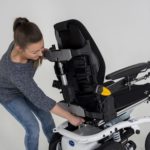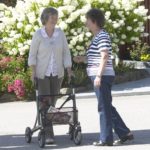Facilitating safe transfers with a Birdie hoist

The Invacare BirdieEvo hoist is what is commonly known as a full-body hoist. This means that it is used for lifting the person up in a sling without weight bearing with the objective being to move the person from A – B.
The need for a BirdieEvo-hoist is when the user becomes unable to safely weight-bear, or apply pressure through their feet to facilitate a safe standing transfer. There is no single or straightforward reason for this to be the case but in my clinical experience there are some common themes including:
- Degeneration of long-term neurological condition
- Acute neurological event (such as a stroke)
- Traumatic orthopedic fracture with complex co-morbidities
- Dementia related physical or cognitive impairment
The challenge with ‘full-body’ hoisting is often it is the environment that increases the risks although there are elements of each of the TILE (task, individual, load & environment) that will have an impact. Invacare have created a range that includes a Birdie Evo hoist, Birdie Evo Compact and a Birdie Evo Plus hoist that provide flexibility to work within the space available.
Any professional recommendation for an Invacare Birdie hoist will be accompanied by a moving & handling plan/handling risk assessment. This handling plan, which can be either formal or informal informs carers, how the healthcare professional feels safety can be maximised, both for the user and the carers.
Although not universally in a standard format these risk assessments will always cover TILE or PEO models.
Facilitating safety
Task/Occupation
This refers to reviewing which tasks are being completed at any one time. The Birdie hoist can support multiple tasks including:
- Bed transfer
- Toilet transfer
- Chair transfer
- Wheelchair transfer
- Leg lifting (usually into bed)
- Raising from the floor
Each of the these tasks then supports an activity or occupation, from eating/drinking, maintaining personal hygiene, toileting, socialising/engaging in leisure activity. This also means that they each need to be individually risk assessed to ensure risks reduced.
Individual/Person
In this instance it refers to the carer completing the hoisting task. Considerations include:
- Height & body shape
- Physical ability
- Experience
- Emotional involvement (particularly for informal/family carers)
Load
In the case of patient/person handling the load is indeed the person. Areas of risk/assessment include:
- Ability to support carers in sling application
- Behaviors (particularly when challenging)
- Physical risks, for example dislocation if low tone or skin integrity
- Catheter/syringe driver or other medical/nursing appliances
Environment
Critical to successful hoisting there are many environmental factors that need to be reviewed when facilitating safe transfers with the Birdie EVO hoist.
These include but certainly not limited to:
- Space/turning circle
- Flooring
- Trailing flexes
- Working temperature
- Proximity to open fires etc
- Internal doorway widths
- Access to appropriately positioned furniture.
Summary
Once the above risk assessments have been completed the Healthcare professional would make recommendations about what equipment is most suitable to meet all of the identified criteria.
What the Invacare Birdie EVO hoist and Birdie EVO Compact and Birdie EVO plus offer is safety and comfort with flexibility.
The Birdie EVO hoist is a redesigned version of the market leading Birdie mobile floor lifter. With unique new features this newer model offers even more comfort and safety while hoisting clients. It is designed for use in both home-care and long-term care environments. With the patented Slow’R element reducing rocking and increasing comfort for patients and the SMARTLOCK ™ and improved hook design improving usability for carers, the Birdit EVO is set to even more popular than its predecessor. Like the original Birdie the Birdie EVO offers a longer boom providing more flexibility for the larger or taller individual, reducing risks of skin damage or discomfort as a result of impact with hoist body. The ability to spread the legs wider allows the hoist to be positioned appropriately around most chairs including mechanised recliners which other hoists often do not.
The Birdie EVO Compact hoist combines all the features of the standard Bridie EVO but in a small footprint. being smaller; allows it to turn in spaces other hoists would not. The shorter and narrow base allows it to negotiate narrower internal doorways and corridors so that it can be moved between rooms making all areas of the home or healthcare facility accessible to client.
The Birdie EVO Plus is the premier model in the range. Similar in size to the Bridie EVO the Plus offers advanced control unit with monitoring capabilities. It is designed for those care centres where the hoist will be used more frequently and so is a more robust model.
Birdie hoists come with a variety of optional additions including 4 way spreader bars for increased positional flexibility, long handle or electronic option for operation of leg spreading, and push bar handles all of which enhance the experience of those involved.
In addition to this all models are designed to easily fold and unfold so that they can be stored within the home or taken in the boot of a car to support engagement in activity outside of the normal residence.







